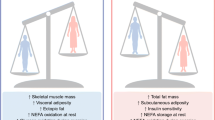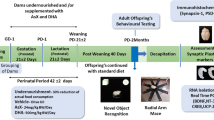Abstract
Purpose
Prenatal undernutrition followed by postweaning feeding of a high-fat diet results in obesity in the adult offspring. In this study, we investigated whether diet-induced thermogenesis is altered as a result of such nutritional mismatch.
Methods
Female MF-1 mice were fed a normal protein (NP, 18 % casein) or a protein-restricted (PR, 9 % casein) diet throughout pregnancy and lactation. After weaning, male offspring of both groups were fed either a high-fat diet (HF; 45 % kcal fat) or standard chow (C, 7 % kcal fat) to generate the NP/C, NP/HF, PR/C and PR/HF adult offspring groups (n = 7–11 per group).
Results
PR/C and NP/C offspring have similar body weights at 30 weeks of age. Postweaning HF feeding resulted in significantly heavier NP/HF offspring (P < 0.01), but not in PR/HF offspring, compared with their chow-fed counterparts. However, the PR/HF offspring exhibited greater adiposity (P < 0.01) v the NP/HF group. The NP/HF offspring had increased energy expenditure and increased mRNA expression of uncoupling protein-1 and β-3 adrenergic receptor in the interscapular brown adipose tissue (iBAT) compared with the NP/C mice (both at P < 0.01). No such differences in energy expenditure and iBAT gene expression were observed between the PR/HF and PR/C offspring.
Conclusions
These data suggest that a mismatch between maternal diet during pregnancy and lactation, and the postweaning diet of the offspring, can attenuate diet-induced thermogenesis in the iBAT, resulting in the development of obesity in adulthood.



Similar content being viewed by others
References
Rader DJ (2007) Effect of insulin resistance, dyslipidemia, and intra-abdominal adiposity on the development of cardiovascular disease and diabetes mellitus. Am J Med 120:S12–S18
Aggoun Y (2007) Obesity, metabolic syndrome, and cardiovascular disease. Pediatr Res 61:653–659
Armitage JA, Poston L, Taylor PD (2008) Developmental origins of obesity and the metabolic syndrome: the role of maternal obesity. Front Horm Res 36:73–84
Law CM, Barker DJ, Osmond C et al (1992) Early growth and abdominal fatness in adult life. J Epidemiol Community Health 46:184–186
Lewis DS, Bertrand HA, McMahan CA et al (1986) Preweaning food intake influences the adiposity of young adult baboons. J Clin Invest 78:899–905
Budge H, Gnanalingham MG, Gardner DS et al (2005) Maternal nutritional programming of fetal adipose tissue development: long-term consequences for later obesity. Birth Defects Res C Embryo Today 75:193–199
Hales CN, Barker DJ (2001) The thrifty phenotype hypothesis. Br Med Bull 60:5–20
Vickers MH, Breier BH, McCarthy D et al (2003) Sedentary behavior during postnatal life is determined by the prenatal environment and exacerbated by postnatal hypercaloric nutrition. Am J Physiol Regul Integr Comp Physiol 285:R271–R273
Bellinger L, Sculley DV, Langley-Evans SC (2006) Exposure to undernutrition in fetal life determines fat distribution, locomotor activity and food intake in ageing rats. Int J Obes 30:729–738
Kind KL, Clifton PM, Grant PA et al (2003) Effect of maternal feed restriction during pregnancy on glucose tolerance in the adult guinea pig. Am J Physiol Regul Integr Comp Physiol 284:R140–R152
Gluckman PD, Hanson MA, Spencer HG (2005) Predictive adaptive responses and human evolution. Trends in Endocrinol Metab 20:527–533
Vickers MH, Breier BH, Cutfield WS (2000) Fetal origins of hyperphagia, obesity and hypertension and its postnatal amplification by hypercaloric nutrition. Am J Physiol Endocrinol Metab 279:E83–E87
Ozanne SE, Hales CN (2002) Early programming of glucose-insulin metabolism. Trends Endocrinol Metab 13:368–373
Eriksson JG, Forsen TJ, Osmond C et al (2003) Pathways of infant and childhood growth that lead to type 2 diabetes. Diabetes Care 26:3006–3010
Desai M, Babu J, Ross MG (2007) Programmed metabolic syndrome: prenatal undernutrition and postweaning overnutrition. Am J Physiol Regul Integr Comp Physiol 293:R2306–R2314
Cypess AM, Kahn CR (2010) The role and importance of brown adipose tissue in energy homeostasis. Curr Opin Pediatr 22:478–484
Enerbäck S (2010) Human brown adipose tissue. Cell Metab 11:248–252
Heaton JM (1972) The distribution of brown adipose tissue in the human. J Anat 112:35–39
Enerbäck S (2010) Brown adipose tissue in humans. Int J Obes 34:S43–S46
Cannon B, Nedergaard J (2004) Brown adipose tissue: function and physiological significance. Physiol Rev 1:277–359
Shibata H, Nagasaka T (1984) Role of sympathetic nervous system in immobilization- and cold-induced brown adipose tissue thermogenesis in rats. Jpn J Physiol 34:103–111
Klingenspor M (2003) Cold-induced recruitment of brown adipose tissue thermogenesis. Exp Physiol 88:141–148
Mercer SW, Trayhurn P (1984) Effect of high fat diets on the thermogenic activity of brown adipose tissue in cold-acclimated mice. J Nutr 114:1151–1158
Bachman ES, Dhillon H, Zhang CY et al (2002) βAR signaling required for diet-induced thermogenesis and obesity resistance. Science 297:843–845
Lowell BB, Bachman ES (2003) β-Adrenergic receptors, diet-induced thermogenesis, and obesity. J Biol Chem 278:29385–29388
Feldmann HM, Golozoubova V, Cannon B et al (2009) UCP1 ablation induces obesity and abolishes diet-induced thermogenesis in mice exempt from thermal stress by living at thermoneutrality. Cell Metab 9:203–209
Watkins AJ, Ursell E, Panton R et al (2008) Adaptive responses by mouse early embryos to maternal diet protect fetal growth but predispose to adult onset disease. Biol Reprod 78:299–306
Watkins AJ, Wilkins A, Cunningham C et al (2008) Low protein diet fed exclusively during mouse oocyte maturation leads to behavioural and cardiovascular abnormalities in offspring. J Physiol 586:2231–2244
Tentolouris N, Pavlatos S, Kokkinos A et al (2008) Diet-induced thermogenesis and substrate oxidation are not different between lean and obese women after two different isocaloric meals, one rich in protein and one rich in fat. Metabolism 57:313–320
Surwit RS, Wang S, Petro AE et al (1998) Diet-induced changes in uncoupling proteins in obesity-prone and obesity-resistant strains of mice. Proc Natl Acad Sci USA 95:4061–4065
Coscina DV, Chambers JW, Park I et al (1985) Impaired diet-induced thermogenesis in brown adipose tissue from rats made obese with parasagittal hypothalamic knife-cuts. Brain Res Bull 14:585–593
De Luca B, Monda M, Amaro S et al (1989) Lack of diet-induced thermogenesis following lesions of paraventricular nucleus in rats. Physiol Behav 46:685–691
Howitt L, Sandow SL, Grayson TH et al (2011) Differential effects of diet-induced obesity on BKCa β1-subunit expression and function in rat skeletal muscle arterioles and small cerebral arteries. Am J Physiol Heart Circ Physiol 301:H29–H40
Frisbee JC (2007) Vascular dysfunction in obesity and insulin resistance. Microcirculation 14:269–271
Zhu MJ, Ford SP, Means WJ et al (2006) Maternal nutrient restriction affects properties of skeletal muscle in offspring. J Physiol 575:241–250
Illner K, Brinkmann G, Heller M et al (2000) Metabolically active components of fat free mass and resting energy expenditure in nonobese adults. Am J Physiol Endocrinol Metab 278:E308–E315
Srikanthan P, Karlamangla AS (2011) Relative muscle mass is inversely associated with insulin resistance and prediabetes. Findings from the third National Health and Nutrition Examination Survey. J Clin Endocrinol Metab 96:2898–2903
Liu X, Rossmeisl M, McClaine J et al (2003) Paradoxical resistance to diet-induced obesity in UCP1-deficient mice. J Clin Invest 111:399–407
Gong DW, He Y, Karas M (1997) Uncoupling protein-3 is a mediator of thermogenesis regulated by thyroid hormone, β3-adrenergic agonists, and leptin. J Biol Chem 272:24129–24132
Symonds ME, Pearce S, Bispham J (2004) Timing of nutrient restriction and programming of fetal adipose tissue development. Proc Nutr Soc 63:397–403
Clarke L, Bryant MJ, Lomax MA et al (1997) Maternal manipulation of brown adipose tissue and liver development in the ovine fetus during late gestation. Br J Nutr 77:871–883
Clarke L, Heasman L, Firth K et al (1997) Influence of route of delivery and ambient temperature on thermoregulation in newborn lambs. Am J Physiol 272:R1931–R1939
Hahn P, Novak M (1975) Development of brown and white adipose tissue. J Lipid Res 16:79–91
Hahn P, Drahota Z, Skala J et al (1969) The effect of cortisone on brown adipose tissue of young rats. Can J Physiol Pharmacol 47:975–980
Daniel H, Derry DM (1969) Criteria for differentiation of brown and white fat in the rat. Can J Physiol Pharmacol 47:941–945
Sarr O, Yang K, Regnault TR (2012) In utero programming of later adiposity: the role of fetal growth restriction. J Pregnancy 2012:134758
Symonds ME (2013) Brown adipose tissue growth and development. Scientifica 2013:305763
Gluckman PD, Hanson MA, Beedle AS (2007) Early life events and their consequences for later disease: a life history and evolutionary perspective. Am J Hum Biol 19:1–19
Acknowledgments
We thank T.J. Wong and A. Ismail for their technical assistance. The study was supported by the Biotechnology and Biological Sciences Research Council (BB/I001840/1 and BB/F007450/1 to T.P.F., and BB/G01812X/1 to F.R.C.). DS was supported by a PhD studentship from the British Medical Research Council.
Conflict of interest
The authors declare no conflict of interest.
Author information
Authors and Affiliations
Corresponding author
Rights and permissions
About this article
Cite this article
Sellayah, D., Dib, L., Anthony, F.W. et al. Effect of maternal protein restriction during pregnancy and postweaning high-fat feeding on diet-induced thermogenesis in adult mouse offspring. Eur J Nutr 53, 1523–1531 (2014). https://doi.org/10.1007/s00394-014-0657-4
Received:
Accepted:
Published:
Issue Date:
DOI: https://doi.org/10.1007/s00394-014-0657-4




